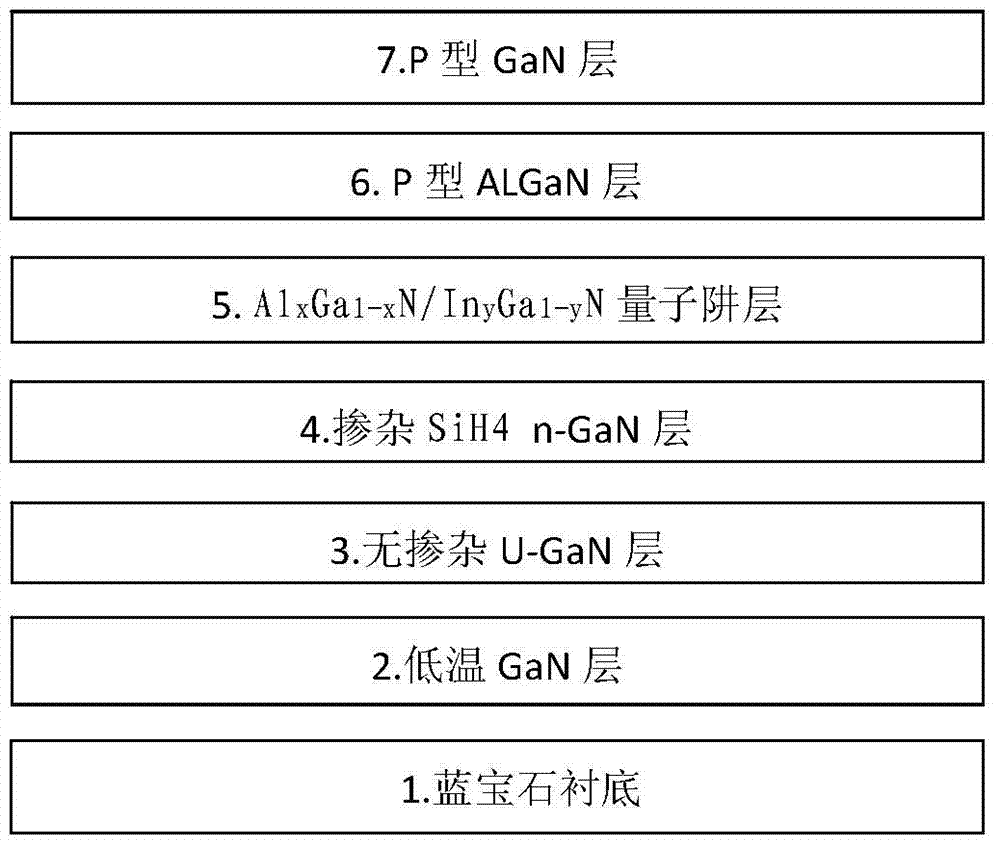Epitaxial growth method for improving LED lighting efficiency
A technology of epitaxial growth and luminous efficiency, applied in the direction of electrical components, circuits, semiconductor devices, etc., can solve the problems of low hole migration ability, reduced luminous efficiency, and inability to migrate, and achieve the effect of improving luminous efficiency
- Summary
- Abstract
- Description
- Claims
- Application Information
AI Technical Summary
Problems solved by technology
Method used
Image
Examples
Embodiment 1
[0024] Embodiment one (the present invention)
[0025] 1. Put the cleaned sapphire substrate into the MOCVD equipment and bake it at 1100°C for 10 minutes.
[0026] 2. A low-temperature GaN layer with a thickness of 10 nm is grown at a cooling temperature of 620° C., and the growth pressure is 500 torr.
[0027] 3. Raise the temperature to 1165°C to grow an undoped u-GaN layer with a thickness of 1.5um, and the growth pressure is 200torr.
[0028] 4. Raise the temperature to 1170°C, grow a silane-doped n-GaN layer with a thickness of 2.0um, and grow at a growth pressure of 200torr.
[0029] 5. Switch the carrier gas from hydrogen to nitrogen at a pressure of 200torr to grow AlxGa1-xN / InyGa1-yN multiple quantum well layers. Lower the temperature to 1075°C to grow an InyGa1-yN quantum well layer with a thickness of 3nm; then raise the temperature to 1165°C to grow an AlxGa1-xN quantum barrier layer with a thickness of 10nm to complete the growth of a pair of quantum wells. Th...
Embodiment 2
[0033] Embodiment 2 (traditional solution)
[0034] 1. Put the cleaned sapphire substrate into the MOCVD equipment and bake it at 1100°C for 10 minutes.
[0035] 2. A low-temperature GaN layer with a thickness of 10 nm is grown at a cooling temperature of 620° C., and the growth pressure is 500 torr.
[0036] 3. Raise the temperature to 1165°C to grow an undoped u-GaN layer with a thickness of 1.5um, and the growth pressure is 200torr.
[0037] 4. Raise the temperature to 1170°C, grow a silane-doped n-GaN layer with a thickness of 2.0um, and grow at a growth pressure of 200torr.
[0038] 5. Switch the carrier gas from hydrogen to nitrogen at a pressure of 200torr to grow AlxGa1-xN / InyGa1-yN multiple quantum well layers. Lower the temperature to 1075°C to grow an InyGa1-yN quantum well layer with a thickness of 3nm; then raise the temperature to 1165°C to grow an AlxGa1-xN quantum barrier layer with a thickness of 10nm to complete the growth of a pair of quantum wells. Then ...
PUM
| Property | Measurement | Unit |
|---|---|---|
| Doping concentration | aaaaa | aaaaa |
Abstract
Description
Claims
Application Information
 Login to View More
Login to View More - R&D
- Intellectual Property
- Life Sciences
- Materials
- Tech Scout
- Unparalleled Data Quality
- Higher Quality Content
- 60% Fewer Hallucinations
Browse by: Latest US Patents, China's latest patents, Technical Efficacy Thesaurus, Application Domain, Technology Topic, Popular Technical Reports.
© 2025 PatSnap. All rights reserved.Legal|Privacy policy|Modern Slavery Act Transparency Statement|Sitemap|About US| Contact US: help@patsnap.com


